
Rhône-Alpes - an area guide
The French Alps and the Rhone valley area
- Explore France ►
- Essential pages
- Travel in France
- Where to go
- What to see and do
About-France.com
- the connoisseur's guide to France
Rhone Alpes is one of the most
prosperous areas of France, famous for its Alpine
ski areas. But the area, which stretches from Lake Geneva
to the Cevennes and Provence, is far more than just the French
Alps.

| Go to ► | Main tourist attractions | Guide to French Alps ski areas | Selected hotels in the French Alps |
Rhone-Alpes - the area around Lyon
Find
hotels
in the Rhone Alpes

Click
for best
online rates for hotels in or close to
Lyon
Grenoble
Geneva
Evian
Chamonix
Annecy
Aix les Bains
Chambery
Valence
St Etienne
Ardèche
Montelimar
Courchevel
Vercors
Savoie

Grenoble
Geneva
Evian
Chamonix
Annecy
Aix les Bains
Chambery
Valence
St Etienne
Ardèche
Montelimar
Courchevel
Vercors
Savoie
About-France.com
is
partnered with Booking.com, to
bring you the best online prices
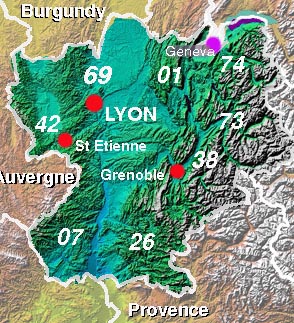 Rhône-Alpes
,
centered on France's second city, Lyon, was previously one of the
larger
traditional regions in
France, encompassing eight departments. Since 2016, it has
been merged into a new larger region known as Auvergne-Rhone-Alpes.
Rhône-Alpes
,
centered on France's second city, Lyon, was previously one of the
larger
traditional regions in
France, encompassing eight departments. Since 2016, it has
been merged into a new larger region known as Auvergne-Rhone-Alpes. With its three main cities, Lyon, Grenoble and St. Etienne, plus the area that includes the French suburbs of the Swiss city of Geneva, Rhone-Alpes is one of the more prosperous areas in France.
The area includes all or a large part of different historic provinces, including the Savoy and the Dauphiné, as well as a small northern part of Provence, known as "Drome Provençal". It stretches from the plains of the Bresse, in the north, to the lower reaches of the Rhone, in the south; and from the highest peaks of the Alps, on the Italian border in the east, to beyond the Loire in the west. It has international borders with Switzerland and Italy, and lies astride the main lines of communication from northern and central France to these two countries.
Departments of the Rhone Alpes
The eight departments of the Rhone-Alpes area are, from northwest to southeast: the Rhône department (69), around and to the north of Lyon, the Ain (01) in the northeast, including the Bresse plain and the southern part of the Jura; the Haute Savoie (74) and Savoie (73), two Alpine departments; the Loire (42) to the east of Lyon, the Isère (38) stretching from the Italian border almost to Lyon, the Ardèche, (07), the dry eastern flank of the Massif Central, and the Drôme (26), mostly made up of the southwestern foothills of the Alps.
The diversity of the Rhône-Alpes area
The area's identity is defined on the one hand by the river Rhone and its tributaries, and by the other hand by its Alpine uplands. The Rhône enters France at Geneva, follows a twisting course as far as Lyon, then heads due south towards the Mediterranean. From Lyon to the Mediterranean, the Rhone valley is one of Europe's major historic lines of communication, the shortest historic route between north and south, avoiding a crossing of the Alps or a large detour.The area has a mixed economy: Lyon is traditionally a centre for the petrochemical and pharmaceutical industries, though also a major centre for service industries. Grenoble is one of the most important high-tech cities in France, a city which boomed in the high-tech revolution, when start-ups and international firms such as Hewlett Packard were attracted by the city's attractive location at the foot of the Alps. .
In the northeast of the region, there lies a very prosperous area made up of the French suburbs of Geneva and the resorts on the southern shores of Lake Geneva.
More
accommodation ideas
Rural areas
The northern departments of the Rhone Alpes region are relatively prosperous agricultural areas; but in the three main Alpine departments, the rural economy is heavily dependent on tourism, both in summer and winter. These Alpine departments boast many of the most popular, most accessible and most prestigious ski areas in France . The hilly country of the Drome and Ardèche departments does not offer a lot of good agricultural land, except in the valleys, where fruit and vegetables are a major industry; but in recent years, both these industries have suffered on account of cheaper imports from southern Europe. The Ardèche is a particularly dry department, offering the northernmost expanses of classic Mediterranean hinterland, "garrigue" or arid hills covered in scrub and coarse vegetation.Vineyards
The Rhône-Alpes region also has some reputed vineyard areas, in particular the Beaujolais area to the north of Lyon, and the northern part of the Côtes du Rhône area south of Lyon. Among the most attractive are the terraced vineyards around the steep-sided Rhone valley between Vienne and Valence, with appellations such as Crozes-Hermitage, Saint Joseph, and Côte Rôtie. Rather less well-known are the vineyards of the Savoy area, which produce some good fruity white wines, and the vineyards of the Ardèche which produce Mediterranean-style redsAccess to Rhone Alpes
Access by train (direct TGV) from Paris Gare de Lyon or from Marseilles, Brussels, and other cities. Lyon is just 2hrs by TGV train from Paris.Access by car from the UK: the easiest way is to cross to Calais, then drive down the motorway via Rheims and Dijon, avoiding Paris.
Access by plane: Lyon St. Exupéry airport has good connections throughout Europe, and is a hub for Easyjet. There are also airports with flights from the UK in Grenoble and Chambéry. Just outside the region (just a kilometre from the French border), Geneva Cointrin airport has a wide range of international and intercontinental flights.
Some of the main tourist sites in the Rhône-Alpes
- Aix-les-Bains (73): classic elegant spa town on the eastern shore of the Lac du Bourget.
- The Alps (74, 73, 38) the French part of Europe's most important mountain range, with numerous attractions for summer and winter. Includes la Vanoise and Les Ecrins, two high mountain national parks.
- Annecy (74) Attractive old Alpine town, on the shores of Lake Annecy.
- Bourg en Bresse (01) : ornate late gothic "Eglise de Brou", built as part of a royal monastery by Margaret of Austria. Centre for the Bresse wetlands, an area of lakes and marshes famous for its birdlife. Waterfowl and birdlife park at Villars les Dombes.
- Chamonix (74). the original French winter-sports resort, now just one of many. It is the point of departure for hiking in and around Mont Blanc, Europe's highest peak. ► Chamonix hotels
- Evian, Thonon (74) Chic resorts on the southern shores of Lake Geneva.
- Grenoble (38) Take the cablecar up to the Fort de la Bastille, for an impresssive view down over the town. The National Centre for Contemporary Art is one of the best in France. The Grenoble Museum has a good collection of 19th - 20th century art, including Gaugin, Matisse, Bonnard and Picasso.
- Lac du Bourget (73) an Alpine lake, the largest freshwater lake in France.
- Lyon: (69) The historic city is classed as a UNESCO world heritage site. It lies between the rivers Rhone and Saône, and on the steep western bank of the Saône. The old city has an architectural and cultural heritage spanning over two thousand years. The Musée des Beaux Arts (Fine Arts museum) has a large and varied collection, from Ancient Egyptian artefacts to modern masterpieces, including works by Tintoretto, Reubens, Gauguin, Monet, Picasso and Francis Bacon. ► Lyon hotels
- Mer de glâce, near Chamonix. (Receding) glacier, accessible by rack and pinion train.
- Saint-Etienne (42). Former industrial capital of southern France, the city now boasts several museums including the Mining Museum, the Museum of Art and Industry, and a Design centre. Nearby Firminy has a number of groundbreaking buildings designed by Le Corbusier.
- Vienne (38) Small town on the Rhone, with interesting Roman and medieval remains.
- Vizille (38) Domaine de Vizille - Chateau, extensive landscaped grounds and gardens, and a Museum of the French Revolution.
- The Rhône valley from Vienne to Tournon (38, 07) The Rhone runs through a narrow valley, below some of the more famous of the "Côtes du Rhône" vineyards.
- Tournon (07). Le train du Vivarais, old narrow-gauge steam railway winding up through the terraced valleys of the Ardèche department.
- Vallon-Pont-d'Arc (07) top end of the Ardèche gorges, and site of a famous natural bridge across the river. The Caverne du Pont d'Arc is a remarkable copy of the nearby Grotte Chauvet caves, with their unique collection of prehistoric cave paintings.
- Le Vercors (26) Attractive foothills of the Alps, a good area for hiking, mountain biking and other outdoor pursuits.
- Montélimar (26). For many French people travelling south, Montelimar is where you reach "Le Midi" (the South of France). The city is famous as the home of nougat.
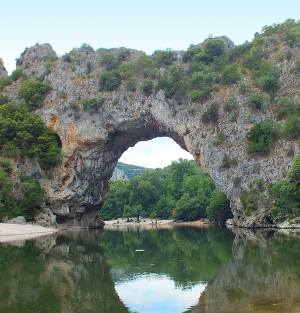
The Pont d'Arc, over the Ardèche river.
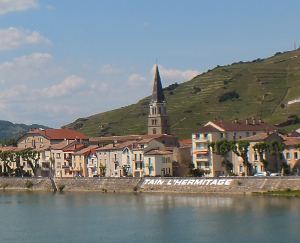
Tain l'Hermitage and its Côtes du Rhône vineyards
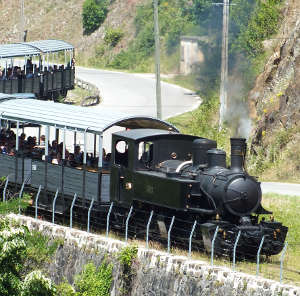
The train du Vivarais at Tournon
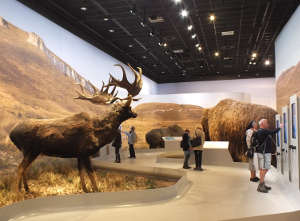
Inside the Caverne de l'Ardèche prehistoric centre
About-France.com
Home
page - Site
search
- Regions
- Maps of France
- Contact
Auvergne-Rhône-Alpes region
Rhône-Alpes area
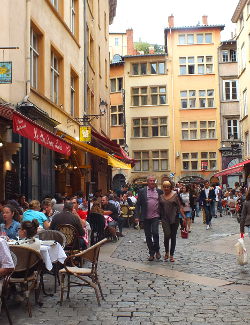
The Renaissance quarter of Old Lyon
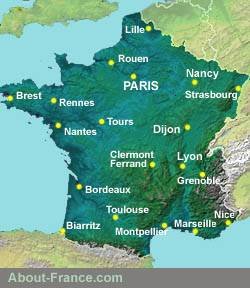
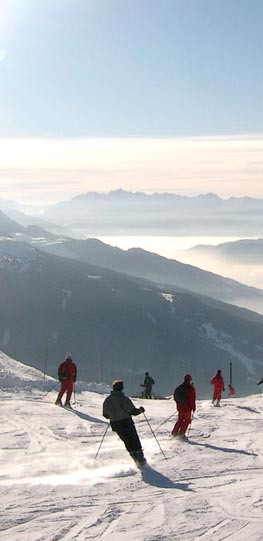
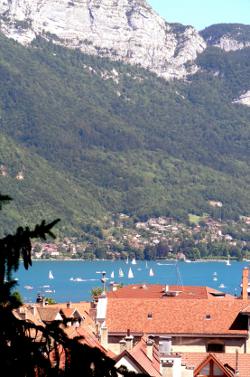
Annecy and Lake Annecy -
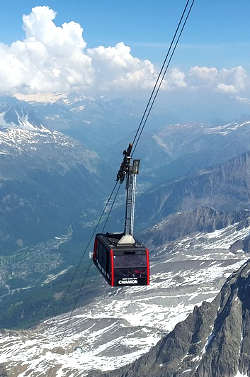
Cablecar above Chamonix

Click here for
low-cost car hire in France
low-cost car hire in France
Texts and photos Copyright © About-France.com 2003 - 2025 except where otherwise indicated.
Photos of Annecy by TpsDave and Paul Roden
Chamonix cablecar by Simon
